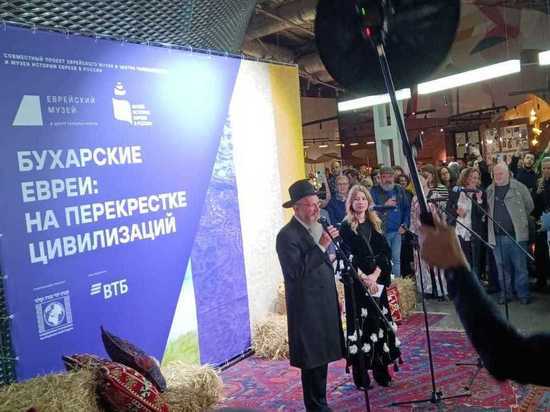On March 2, a large-scale vernissage of the exhibition “The Jews of Bukhara: At the Crossroads of Civilizations” was held at the Jewish Museum and Tolerance Center in Moscow. The project is implemented by the Jewish Museum and the Tolerance Center in cooperation with the Museum of the History of the Jews of Russia (MIEVR).
The main theme of the exhibition was the preservation of its own identity and cultural identity against the background of the cultures of the surrounding peoples, along the historical course of the existence of the Jews of Bukharia.
More than 200 rare and unique pieces were presented at the exhibition, some of them belonged to private collections and had never been exhibited before. Rare documents, vivid paintings, authentic household objects and folk art, exquisite handicrafts and multicolored spices all took the audience to distant sunny Central Asia.
Part of the exhibition was devoted to the decor of traditional Jewish houses in Samarkand and Bukhara from the end of the 19th century to the first third of the 20th century.
An important place in the exhibition was given to the traditional clothes of the Jews of Bukharia and samples of weaving and gold embroidery. Most of the works that the evening’s guests saw are part of the collection of the Museum of the History of the Jews of Russia and were collected from Jewish families during museum expeditions in Central Asia. In addition, the exhibition presented pieces from the collection of the Russian Ethnographic Museum, the Marjani Foundation and private collections. In the lobby bar, guests were treated to carefully prepared traditional dishes of Judeo-Bukharian cuisine.
According to the creators of the project, there has never been an exhibition of such scope and content in an ethnographic, Jewish or art museum.
Our readers will also be curious to know a little more about the Bukharan Jews. It’s no secret that until the 1970s, Bukharan Jews lived in Central Asia, mainly in Uzbekistan and Tajikistan.
The term “Bukhara Jews” was attributed to members of the community because before Russia’s conquest of Central Asia, a significant part of the community lived in the territory of the Bukhara Khanate. The Bukharian Jews themselves call themselves “Isroil” or “Yahudi”.
Bukhara is a fabulous old city in central Uzbekistan, once home to a large Jewish community. Today, by most estimates, there are only a few families of true Bukharan Jews left.
It is important to point out that despite all the difficulties that our brothers experienced when they lived in Central Asia, the Bukharan Jews played a very important role in the development of the local musical culture and traditional crafts. , and occupied a prominent place in the system of international exchanges between Russia and the countries of the East. Successful Jewish merchants brought active entrepreneurs, educators and philanthropists among them, who became pioneers in industry, in the field of the introduction of new educational systems, in the field of the development of theater and publishing modern books in the region. Bukharan Jews, as well as Ashkenazi and Mountain Jews, established national collective farms, new schools, served in the Red Army, fought in the Great Patriotic War, among Bukharan Jews there is a significant number of scientists, representatives of science, culture, art, creative intelligentsia.
The gradual exodus of Jews from Bukhara already began in the early 1970s, when the Soviet Union relaxed the ban on emigration. In the 1990s, when Uzbekistan became an independent state, the exodus widened and today most of the Jews of Bukharia ended up in Western Europe, Israel and the United States. However, at all stages of their history and in various integration processes, despite external influences in different countries, the Jews of Bukhara managed not to dissolve into other ethnic groups, retaining their amazing original culture. , their special customs and rituals, their devotion to Judaism.
Visitors to the exhibition “Bukharian Jews: At the Crossroads of Civilizations” addressed the Chief Rabbi of Russia Berl Lazar, head of the public relations department of the Federation of Jewish Communities of Russia, Kristina Georgievna Krasnyanskaya, art critic Russian, curator, executive director of the Jewish Museum and Tolerance Center.
The opening of this exhibition in the Maryina Grove district of Moscow was also attended by representatives of Jewish organizations at the federal and regional levels: Chairman of the Federal Jewish National Cultural Autonomy – Sergey Evgenievich Melnikov, Chairman of the Regional Jewish National Cultural Center of the City of Moscow – Yakushev Spartak Valerievich, members and experts of the All-Russian Congress “World Culture” ethnojournalists, representatives of the Commission on Information Policy of the Council of Nationalities under the Moscow Government, members of the Journalism Youth Club “Digital Media Workshop”, Regional Public Organization “Face to Face: Promoting Dialogue of Religions and Cultures”, RPO TsSKRSIM “Perovo”, journalists of the STMEGI.COM portal, Sergei Lvovich Ustinov, founder and director of the Museum of the History of the Jews of Russia, the famous lawyer Alexander Andreevich Dobrovinsky and many others.
In summary of the evening: I felt the most amazing feelings of this event – as if I had made a short trip to the small homeland of the Jews of Bukharia, where I had never been, fully feeling the alluring smells of their cuisine and spicy spices. , enjoying the bright colors of their utensils and costumes, having become well acquainted with the culture, customs and traditions of the Jews of Bukharia, without leaving the Russian capital. This means that the organizers of the project managed to fully realize their plans. The exhibition is open at the Jewish Museum and Tolerance Center until June 18, 2023, and you also have the chance to visit it, after receiving your share of happiness…


